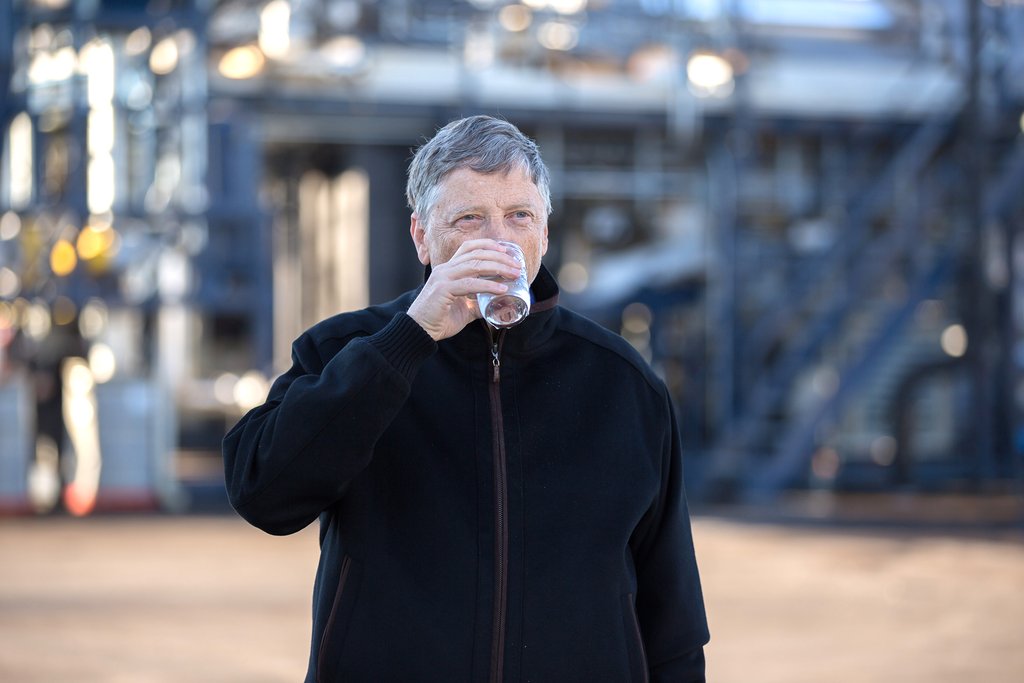Bill Gates wants to help recycle sewage
OmniProcessor produces clean water and electricity from human waste

In the photo above, the richest man on this planet drinks water, which a few minutes before that was excrement. Thus, he sets an example, clearly showing that he is confident in the safety of the developed technology. The demonstration, however, has already caused a number of jokes .
OmniProcessor was shown in Sedro-Woolley, WA. The device was developed by Janicki Bioenergy with funding from the Bill and Melinda Gates Foundation . The plant is able to process up to 14 tons of waste per day and produce clean water and electricity at the outlet.
“This is water!” Exclaims Gates, taking an incredulous sip.
')
Bill Gates today no longer has such an impact on the world of software. The public is much more aware of its philanthropic efforts to help developing countries.
Statistics claim that 40% of the world's population does not have access to an adequate sewer system, the waste of the other 2.1 billion city dwellers is not properly processed. These problems are only exacerbated by the economic situation, for example, in India, they spend $ 54 billion a year on sewers or 6.4% of GDP.
Every year, one and a half million children die from the contamination of food and water. In developing countries, half of all patients in hospitals are there due to a variety of water and sewage problems.
This is what dictated the new initiative. Gates is confident that OmniProcessor can help solve these problems, because the installation is more efficient than conventional processing plants. They take electricity from the grid, release steam directly into the atmosphere, and often buy natural gas to burn liquid sludge.
OmniProcessor itself produces electricity. The creators of the station hope that it will be able to turn processing into a profitable business from an industry that only sucks money.
Janicki Bioenergy is led by Peter Janitzky. Its main company, Janicki Industries, manufactures parts for the aerospace and maritime industries - Lockheed, NASA and General Electric are among its clients. Subsidiary engaged in logging.
But recently, Yanitsky began working in a new direction. It took two years and a small wasteland behind the buildings of his company to create a prototype of the water treatment plant.

OmniProcessor is about the size of two buses, set side to side. The device consists of three main components: a steam power plant, an incinerator and a water filter. The first stage of development was related to the accounting of all energy costs, it was necessary to reduce the loan with a debit, but at the physical level.
On the one hand, a conveyor belt is suitable with which waste is loaded into the installation. The steam engine generates heat for drying. Then the precipitate is boiled to separate the liquid and burned to produce gas for the operation of the steam engine, which together with the generator produces electricity.
To separate any foreign particles and substances, water vapor obtained by draining the sediment passes through a centrifuge and filters. The steam is converted into water in a condenser; water passes through an activated carbon filter.
As Gates stated, water tastes great and he is ready to drink it every day. The product was compared to the usual brands of bottled water from supermarkets, and the water quality from OmniProcessor was not lower.
The installation produces not only water, but also additional electricity. And solid non-toxic residues contain phosphorus and potassium, so they can be used as a fertilizer for the soil.
There is still a lot of work. Gates' visit and related attention marked only the initial phase of the project. Next month, Janicki Bioenergy employees will assemble an installation in the city of Dakar in Senegal for the first test in the countries for which it was created.
The next generation of the recycling station will be able to receive waste of 100 thousand people, producing 250 kilowatts of energy and 86 tons of clean water per day.
The Bill and Melinda Gates Foundation has long shown interest in this area. It all started back in 2005, and in 2010 the Water, Sewage and Hygiene program was launched. She became known for calling for a new type of toilet that does not require electricity, sewage or a water source and costs less than 5 cents per user per day, while meeting the needs of people. At the moment, 16 grants have already been awarded to various organizations around the world. In 2012, the foundation signed a contract with Yanitsky.
According to the materials of the blog of Bill Gates and Wired.com .
Source: https://habr.com/ru/post/375293/
All Articles